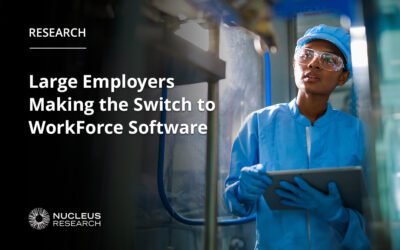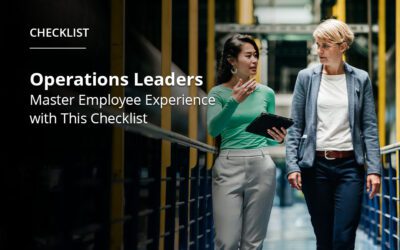A Great Employee Experience Unlocks Employee Engagement in Times of Change


Meghan M. Biro
Founder and CEO of TalentCulture
As organizations navigate an ever-changing economic environment, one prevailing story dominates the minds of business leaders as they steer their enterprises toward the future: the speed of change. From the pandemic and its fallout to economic changes to rapid-scale digital transformation, we don’t work the way we used to—and all the usual functions around managing the workforce have changed as well.
The question is: How can employers address employee engagement effectively in times of change?
Change is Here
The pressure’s on for employers to successfully manage their workforce. New economic challenges—such as a tight labor market and low unemployment—make it a business and HR imperative to harness optimized workforce management solutions. A recent jobs report found that U.S. weekly jobless claims fell by 11,000 to 239,000, indicating that the market is continuing to tighten while job growth slows. Meanwhile, Gallup found that engagement numbers are on the decline again—from 36% of engaged employees in 2020 down to 32% in 2022. We’ve also seen a six-point decline in the past year in terms of the percentage of employees who are extremely satisfied with their organization as a place to work.
By all indications, employees are feeling increasingly disconnected from their employers. But some sectors are seeing the impacts of disengagement more clearly than others. For employers that rely on shift and task-based deskless workforces, it’s vital to prevent the disengagement, performance issues, and churn that can erode your teams. This not only includes turnover, but also absenteeism. According to the AIHR, the U.S. Economy loses $225.8 billion and the European Union loses £470 billion each year to absenteeism. Also, the Bureau of Labor Statistics reported the national absence rate to be 3.6 percent in 2022.
All Eyes on Employee Experience
Employers have a new ally when it comes to keeping their employees engaged—employee experience (EX). A poor employee experience has been identified as one of the root causes of low engagement. Conversely, benchmark research by McKinsey found that a positive employee experience can generate 16 times the engagement level in employees than those with a negative experience—and people who report a positive employee experience are eight times more likely to want to stay with their employer.
For some employers, being able to provide an impactful, positive employee experience for shift workers may not be considered as high a priority—or they often simply don’t have the tools that would enable it. Certainly, for those employees performing shift-based work, the employee experience may be quite different than for knowledge workers, but the same essentials apply, particularly now.
It’s important to be able to offer a seamless, friction-free experience to the shift-based workforce—one that makes them feel valued and connected. This experience is best conveyed via digital technology that reflects an employer’s values and culture, connects employees to managers, and helps employees to quickly thrive in their roles. It also needs to promote an employee’s feeling that they are valued as well as heard, that they belong, and that they are part of a team aligned in task, mission, and performance.
Key Workforce Management Functions: The Sweet Spot
How can you create a truly engaged workforce? It’s not as tall an order as it might seem. Managing a workforce isn’t simple, but there’s a sweet spot between critical capabilities and how service is delivered. You may have all the required features available, but if you’re stuck on a platform that can only be accessed via desktop, or requires employees to navigate multiple layers to access critical information, or if your system has siloes around different functions, that won’t work. For shift-based workers in particular, mobile isn’t a nice to have, it’s a must—and it needs to be user-friendly, seamless, and fast.
As for features, a modern workforce management platform has to be able to tackle the necessities quickly and easily via a range of capabilities, including:
- Scheduling – creates simple, accurate schedules, and can respond to changing demand while handling shift swaps and self-service actions with flexibility.
- Time and attendance – supports accurate tracking and flexibility, minimizing friction between managers and employees.
- Absence, leave, and accommodations – this depends on clear eligibility standards, simple processes for requests and approvals, as well as accurate reporting and compliance features.
- Engagement, performance, and productivity – must capture insights and provide key performance indicators (KPIs) that help incentivize and inspire workers.
- Forecasting – uses data-driven insights to anticipate and forecast demand and accurately scale as needed, providing accurate staffing that minimizes over/under-staffing.
- Safety, security, and compliance – needs to ensure personal data is safe and secure, while enabling compliance across the board.
Human-Centric Management
While having a whole spectrum of features within one central workforce management suite may seem like an HR wish list, increasingly, it’s not. Today’s employees expect these capabilities from a modern workforce management system and want to access an array of tools that make their lives and jobs easier. They want to be treated with trust, transparency, and fairness—and expect that to be conveyed in the management platform itself.
Self-service functions become critical when it comes to timesheets and personal data updates, the flexibility to accommodate shift-swapping and schedule changes, and visibility around payroll adjustments. These capabilities all reflect an employer that is putting its shift, task-based, and deskless employees, as well as their managers, first. The less friction there is around management functions, the more the relationship can grow between managers and their teams. The more clear criteria and communication is, the more trust employees can have in their organization.
That said, it’s not just where these functions are delivered but how that matters most to employees now. Human-centric management is a winning strategy that benefits employees and managers and helps meet business imperatives. It’s marked by three powerful qualities that put people at the center:
- Holistic – Employers must take a holistic view of employee experience, realizing that experience is far more than a moment or single interaction, but the sum total impact of those moments and interactions.
- Integrated – Workforce management should offer an integrated platform that takes the friction out of transferring information from one function to another. It demands a seamless interface to facilitate communication, management, scheduling, workflow and processes, pay, access to information, and interactions around them.
- Facilitating – Workforce management should present solutions to simplify common challenges, so they don’t turn into problems. As we’ve all learned in the past few years, visibility, communication, and flexibility go a long way to improving the employee experience.
Leaning on a modern workforce management solution means employers can respond efficiently to issues in the moment that work happens. It makes it easy for an employee to check their hours, pick up a shift, or reach out to their manager. It enables a busy manager to quickly become aware of workforce concerns, track performance, communicate easily with their teams, monitor staffing levels, and optimize labor usage. And it provides a leader with the means to ensure culture and values aren’t getting lost in the cracks for a more positive employee experience. Seeing ROI on modern workforce management solution investments is supported by continually improving rates of engagement, performance, and retention.
Employee Experience is About People
What came to the fore in the past few years is that, ultimately, it’s an employee’s overall experience that determines how they feel about their employer and their role. Whether a workplace is marked by turnover and absenteeism or a stable workforce and engagement is defined by how organizations meet these increasingly expected employee experience needs. The right digital workforce management tools—along with proper management practices—enable businesses to take a forward-thinking, people-first approach.
While employees need contact and communication to feel that critical sense of belonging no matter where they are, having a powerful modern workforce management solution is essential to enable that connection. Leaders are seeing the overall value of providing this sense of belonging, how it solves problems, and how it connects and empowers their people. In the face of today’s market challenges, an engaged and supported workforce is a win for everyone.
Meghan M. Biro is a talent management visionary, workforce innovator, digital catalyst and podcaster. As founder and CEO of TalentCulture, Meghan has empowered thousands of companies—from early-stage ventures to global brands like Microsoft, IBM and Google—engaging the human connection between recruiters and stellar talent for the betterment of work. Meghan has been a guest on numerous podcasts, radio shows and online forums and has been a featured speaker at global business conferences. She is a regular contributor at Forbes, SHRM and several other media outlets. Meghan regularly serves on advisory boards for leading HR and technology brands.
Subscribe to The WorkForce Blog
Learn the art and science of maintaining productive, happy, engaged employees.
Discover More
Nucleus Insights from WorkForce Customers Research Note
Nucleus Research interviews WorkForce customers who validate why we’re ranked the #1 WFM enterprise vendor for 10 consecutive years.
Elevate Employee Experience: Checklist for Operational Leaders
Get the practical steps and technology functionalities operation leaders need to improve their employees’ work experiences.
Streamlining Complex Workforce Compliance Requirements Boosts Productivity
Discover how workforce compliance software helps EMEA organisations navigate complex legislation, enhance compliance and boost operational efficiency.



